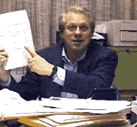McMASTER UNIVERSITY STATISTICS SEMINAR
Week of October 12 - 16, 1998
|
SPEAKER:
|
- Dr Stephen W. Link
- Department
of Psychology, McMaster University
|
|
TITLE:
|
"Predicting Individual Choice"
|
|
DAY:
|
Wednesday, October 14, 1998
|
|
TIME:
|
3:30 p.m. [Coffee in BSB-202 at 3:00 p.m.]
|
|
PLACE:
|
BSB-108
|
SUMMARY
The theory of paired comparisons is often used to determine the
placement of stimuli on psychological dimensions such as the
seriousness of crime, the likeableness of consumables such as fruits
and vegetables, the desirability of political candidates and so
forth. The procedure is lengthy, expensive and difficult to employ in
field work where predicting consumer choice or the vote of a juror is
the goal. Recent theoretical advances offer a new technique that
greatly reduces the number of observations needed to provide accurate
predictions of choices between pairs of a large number of objects. We
will discuss this method and the need for new statistical measures of
goodness of fit in the context of measuring the future.
ABOUT THE SPEAKER
|

|
Dr.
Stephen W. Link received his B.A. in Psychology,
Mathematics and Sociology from the University of Colorado.
Becoming a Fellow in the Institute for Mathematical Studies
in the Social Sciences at Stanford, he received his PhD in
Psychology in 1968. Dr. Link was President of the Society
for Mathematical Psychology (1982), served on the Executive
Committee and Council of the Federation of Behavioral,
Psychological and Cognitive Sciences in Washington, D. C.
representing the scientific interests of its nearly 140,000
members and represented the field of psychology in the
Washington-based Council of Science Society Presidents. His
book series entitled Scientific Psychology published by
Lawrence Erlbaum Associates presents high-level scientific
manuscripts elicited from internationally recognized
scientists. Dr. Link's scientific work focuses on human
discriminability and the measurement of thought.
|
REFERENCES
The following references have been provided by Dr. Link to be
used as background for his talk. They are on reserve at Thode Library
(STATS 770: Statistics Seminar).
[1] Link, S. W. (1992), The Wave Theory of Difference and
Similarity Lawrence Erlbaum Associates, Publishers (in Mills
Library).
[2] Link, S. W. (1990), "Modeling Imageless Thought," JOURNAL OF
MATHEMATICAL PSYCHOLOGY V 34, pp. 2-41.
[3] Link, S. W., Brown, R. and King, R. (1996), "Measuring the
Future," in Proceedings of the Twelfth Annual Meeting of the
International Society for Psychophysics, Fechner Day 96, Padua,
Italy.
Return to the Statistics Activity
Sheet
